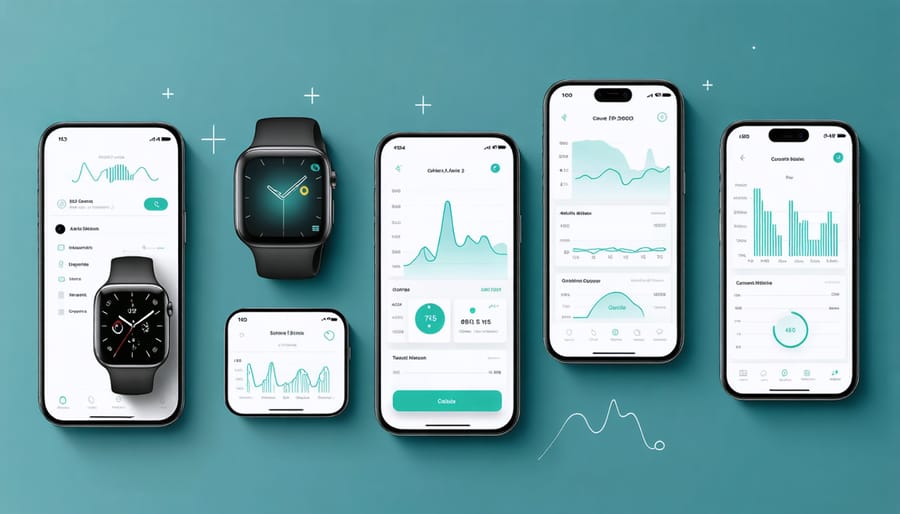Technology is revolutionizing healthcare delivery in ways previously confined to science fiction. From artificial intelligence diagnosing diseases with unprecedented accuracy to remote patient monitoring transforming home care, digital innovations are reshaping every aspect of medical practice. These advancements aren’t just improving treatment outcomes – they’re fundamentally changing how Canadians access, receive, and participate in their healthcare.
The integration of smart devices, telehealth platforms, and digital health records has created a more connected, efficient, and patient-centered healthcare system. Wearable technology now tracks vital signs in real-time, while mobile apps help manage medications and chronic conditions. Virtual consultations have become mainstream, bringing quality healthcare to remote communities and reducing wait times for urban patients alike.
Yet this technological revolution extends beyond traditional medical care. Mental health apps provide 24/7 support, while predictive analytics help prevent disease outbreaks before they spread. Robotics assist in complex surgeries, and 3D printing creates customized medical devices and prosthetics at a fraction of traditional costs.
As we embrace these innovations, we’re witnessing a shift from reactive to proactive healthcare, where technology empowers both healthcare providers and patients to make better-informed decisions about health and wellness.

Digital Health Records: Your Medical History at Your Fingertips
Benefits of Digital Health Records
Digital health records have revolutionized healthcare delivery in Canada, making it easier for medical professionals to provide better, more coordinated care. When your health information is stored digitally, doctors and specialists can access your complete medical history, test results, and medication records instantly, leading to more informed decisions about your treatment.
These electronic systems significantly reduce the risk of medical errors caused by illegible handwriting or misplaced paper charts. Healthcare providers can quickly spot potential drug interactions, allergies, and contraindications, helping to prevent adverse reactions and complications.
Digital records also enable seamless communication between different healthcare facilities and specialists. If you visit an emergency room or a new clinic, your medical history is readily available, ensuring continuity of care. This coordination is particularly valuable for managing chronic conditions that require ongoing monitoring and multiple healthcare providers.
For patients, digital health records mean fewer repeated tests, more efficient appointments, and better access to their own health information through patient portals. This increased transparency helps you become more engaged in your healthcare decisions and better understand your treatment plans.
Privacy and Security Considerations
As healthcare becomes increasingly digital, protecting patient information has become a top priority. Healthcare providers in Canada must comply with strict privacy laws, including the Personal Information Protection and Electronic Documents Act (PIPEDA) and provincial health information protection legislation.
Digital health records and telemedicine platforms use advanced encryption and secure servers to protect sensitive patient data. Multi-factor authentication, regular security audits, and staff training help prevent unauthorized access and data breaches. Healthcare organizations also implement strict protocols for data sharing and storage to ensure patient confidentiality.
Patients can protect their health information by using strong passwords, enabling two-factor authentication on health apps, and being cautious about sharing health data on social media or unsecured platforms. It’s important to verify the security features of any health-related technology before use and to understand how your personal information will be collected, stored, and used.
Healthcare providers continue to invest in cybersecurity measures to stay ahead of emerging threats while maintaining the convenience and accessibility of digital health services.

Telemedicine: Healthcare from the Comfort of Home
When to Use Virtual Care
Virtual healthcare services offer convenient access to medical care, but it’s important to know when they’re most appropriate. These services are ideal for non-emergency conditions like mild respiratory infections, skin rashes, prescription renewals, and mental health consultations.
Consider virtual care when you:
– Need medical advice for common ailments
– Want to discuss test results
– Require medication management
– Experience mild anxiety or depression
– Need routine follow-up appointments
– Have mobility challenges making in-person visits difficult
– Live in remote areas with limited access to healthcare facilities
However, certain situations require in-person medical attention, including:
– Severe chest pain or difficulty breathing
– Serious injuries or accidents
– Complex physical examinations
– Medical emergencies
– Conditions requiring hands-on procedures
Before choosing virtual care, check if your healthcare provider offers these services and whether your provincial health insurance covers them. Many Canadian healthcare providers now integrate virtual options into their practice, making it easier to access care when appropriate. Remember to prepare for your virtual appointment by finding a quiet, private space with good internet connectivity and having your health information ready to share.
Making the Most of Virtual Appointments
To make the most of your virtual healthcare appointments, preparation is key. Start by finding a quiet, well-lit space with a reliable internet connection. Test your device’s camera and microphone beforehand to ensure clear communication with your healthcare provider.
Keep a list of your current medications, symptoms, and questions ready. Consider taking notes about your health concerns in the days leading up to the appointment, including when symptoms occur and their severity. This information helps your healthcare provider make more accurate assessments.
During the appointment, speak clearly and describe your symptoms in detail. If possible, have relevant health data ready, such as blood pressure readings, temperature, or blood sugar levels. For visible symptoms, good lighting helps your provider see clearly through the camera.
Take notes during the consultation and don’t hesitate to ask for clarification. If you need a prescription or referral, confirm how these will be handled before ending the call. Many Canadian healthcare providers can send prescriptions directly to your pharmacy.
Remember that while virtual appointments are convenient, some health concerns require in-person assessment. Your healthcare provider will advise if you need to visit a clinic or hospital for further examination.
After the appointment, follow up on any recommended actions and keep a record of the consultation details for future reference.

Health Apps and Wearables: Your Personal Health Assistant
Choosing the Right Health Apps
With thousands of health apps available, selecting the right ones can feel overwhelming. To make an informed choice, start by checking if the app is approved by Health Canada or recognized by Canadian healthcare organizations. Look for apps that clearly state their privacy policies and how they protect your personal health information.
Evidence-based apps often partner with medical institutions or have research backing their effectiveness. Read user reviews, but focus on detailed feedback rather than just star ratings. Consider apps that integrate with other health devices or services you already use, making it easier to track your overall health journey.
For mental health apps, ensure they’re developed by qualified mental health professionals. Fitness apps should offer proper form guidance and allow you to set realistic, personalized goals. Many Canadian healthcare providers now recommend specific apps – ask your healthcare team for suggestions tailored to your needs.
Be wary of apps making extraordinary claims or promising quick results. The best health apps typically offer a free trial period, allowing you to test their features and usability. Remember that even the most highly-rated app should complement, not replace, professional medical advice and treatment.
Smart Health Monitoring
The rise of smart health monitoring devices has revolutionized how Canadians track and manage their well-being. From fitness trackers to smartwatches, the benefits of wearable technology include real-time health data monitoring, personalized fitness goals, and early detection of potential health issues.
These devices can track vital signs like heart rate, sleep patterns, and activity levels, providing valuable insights into daily health patterns. Many Canadians use these tools to maintain consistent exercise routines, monitor stress levels, and make informed decisions about their lifestyle choices.
While smart monitoring devices offer unprecedented access to personal health data, it’s important to understand their limitations. These tools should complement, not replace, regular medical check-ups and professional healthcare advice. Some devices may have accuracy variations, and not all features are suitable for every user’s needs.
Privacy and data security are also important considerations. Users should carefully review privacy settings and understand how their health data is stored and shared. Despite these challenges, smart health monitoring continues to evolve, offering increasingly sophisticated tools for preventive healthcare and wellness management.
Balancing Technology Use with Mental Wellness
While technology has revolutionized healthcare delivery, it’s crucial to understand its mental health impacts and maintain a balanced approach to digital health tools. The constant connectivity and information flow can sometimes lead to anxiety, digital fatigue, and feelings of being overwhelmed.
Healthcare providers and patients alike need to recognize the signs of digital overwhelm, which may include difficulty concentrating, increased stress levels, or sleep disturbances. To address these challenges, developing healthy tech habits is essential for both healthcare professionals and patients.
Consider implementing these practical strategies:
– Set specific times for checking health apps and monitoring devices
– Take regular breaks from screens during the workday
– Practice mindful technology use by turning off non-essential notifications
– Create tech-free zones or periods, especially during meals and before bedtime
– Balance virtual healthcare appointments with in-person visits when appropriate
Healthcare organizations across Canada are increasingly incorporating digital wellness programs into their services. These programs help users maximize the benefits of health technology while minimizing potential negative effects on mental well-being.
Remember that technology should enhance, not replace, traditional aspects of healthcare and personal wellness. It’s important to maintain human connection and face-to-face interactions alongside digital health solutions. When using health apps or monitoring devices, focus on those that provide genuine value to your health journey rather than adopting every new technology available.
For healthcare providers, establishing clear boundaries between work and personal time becomes especially important in an increasingly connected healthcare environment. This might include setting specific hours for virtual consultations and ensuring adequate offline recovery time.
By maintaining awareness of our technology use and implementing mindful practices, we can harness the benefits of digital health tools while protecting our mental wellness.
The Future of Healthcare Technology in Canada
Canada’s healthcare system is on the brink of a technological revolution that promises to enhance patient care and improve health outcomes. Virtual care platforms are becoming increasingly sophisticated, allowing Canadians to connect with healthcare providers from the comfort of their homes. These solutions are particularly valuable for residents in remote communities who previously faced challenges accessing specialized care.
Artificial Intelligence and machine learning are set to transform diagnostic processes, with Canadian hospitals already implementing AI-powered imaging systems that can detect potential health issues earlier and more accurately. This technology is especially promising for conditions like cancer and heart disease, where early detection is crucial.
Wearable technology and smart devices are evolving to provide more comprehensive health monitoring. These devices will increasingly integrate with electronic health records, allowing healthcare providers to track patients’ vital signs and activity levels in real-time, leading to more personalized treatment plans.
Robotics in healthcare is another growing field, with Canadian institutions investing in surgical robots and automated pharmacy systems. These innovations are expected to increase precision in medical procedures and reduce medication errors.
Digital therapeutics and mobile health apps are emerging as valuable tools for managing chronic conditions and mental health. These technologies will help Canadians take a more active role in their health management while staying connected with their healthcare teams.
Looking ahead, blockchain technology may revolutionize health data management, ensuring secure sharing of medical information across different healthcare providers while maintaining patient privacy. This advancement could lead to more coordinated care and better health outcomes for Canadians.
These technological developments are reshaping healthcare delivery while maintaining the core values of Canada’s universal healthcare system: accessibility, quality, and efficiency.
The integration of technology in healthcare represents a transformative shift that continues to enhance patient care and medical outcomes across Canada. From AI-powered diagnostics to virtual healthcare platforms, these innovations are making healthcare more accessible, efficient, and personalized than ever before. The adoption of electronic health records has significantly improved information sharing between healthcare providers, leading to better-coordinated care and reduced medical errors.
To make the most of these technological advancements, Canadians can take several practical steps. Start by familiarizing yourself with your healthcare provider’s patient portal and digital communication tools. Consider downloading reliable health monitoring apps that align with your wellness goals. If available in your region, register for virtual care services to access medical consultations from home when appropriate.
Remember that while technology offers powerful tools for health management, it works best when combined with traditional healthcare practices. Stay informed about new healthcare technologies through reliable sources, but always consult with healthcare professionals before making significant changes to your health routine.
Looking ahead, the continued evolution of healthcare technology promises even more personalized and preventive care solutions. By embracing these innovations while maintaining a balanced approach to health management, Canadians can actively participate in shaping a healthier future for themselves and their communities.

